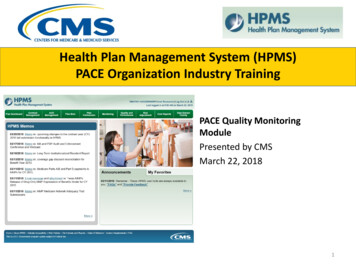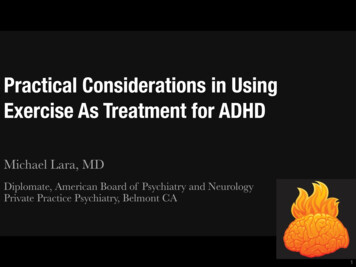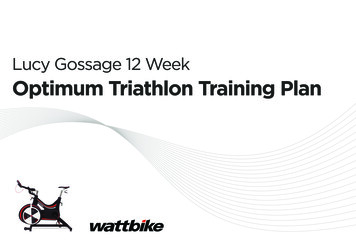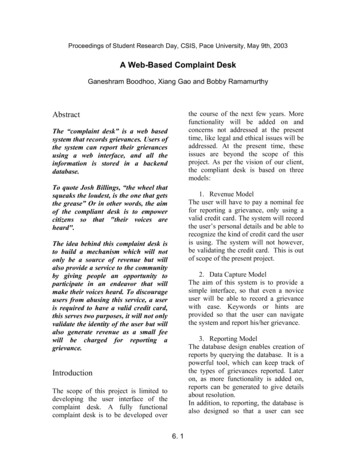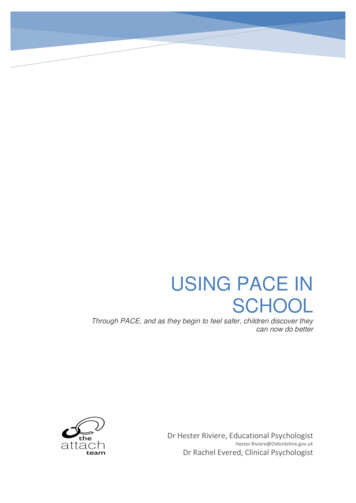
Transcription
USING PACE INSCHOOLThrough PACE, and as they begin to feel safer, children discover theycan now do betterDr Hester Riviere, Educational PsychologistHester.Riviere@Oxfordshire.gov.ukDr Rachel Evered, Clinical Psychologist
Using PACE in SchoolThis leaflet is designed to help you to have effective, empowering interactions withchildren who have experienced trauma and who, as a result, do not respond to youin the same way as other children you teach.Children who have had a difficult start to life have often learned that the world is nota safe place and that people in it cannot be trusted to help them to stay safe. Withoutsafety and security children cannot settle to learn and explore. Many also do notthink that they deserve care and attention, and many feel deeply ashamed much ofthe time. These feelings and assumptions about the world underpin all theinteractions they have with you and their peers.Working with children who do not feel safe at school is demanding and asks a lot ofyou as a professional. We hope that this leaflet will give you some more informationabout why you are successful when you are successful, why things sometimes gowrong, and some ideas for helping hard-to-reach children be settled and able tolearn in your class.
Understanding how feelings direct actionsThe work of neuropsychologist Stephen Porges has helped us to understand whathappens to us all when we perceive danger. His polyvagal theory suggests ahierarchy of three levels:When we do not feel safe, the body prepares itself to respond to danger. If thedanger seems very great, the nervous system is activated in such a way that wehave a very high tolerance for pain, and often become very still. In this ‘freeze’ state,which is the state of greatest stress, children sometimes appear to ‘zone out’, showconfusing behaviours such as laughing inappropriately as though they cannot stop,or even appear to fall asleep. Sometimes this is called “dissociation”.When we perceive threat that is not at the highest level the body prepares itself fordefence. Sometimes we call this “fight or flight”. It is likely that you have seen thisresponse on many occasions. Children who have experienced trauma escalate intothis state very quickly. It may look as though there was no trigger, or that theapparent trigger was very small.Many children who have experienced trauma are vulnerable to experiencing ‘fight,fright or flight’ reactions in everyday situations which would not normally makechildren feel afraid. This reaction is not conscious, is completely involuntary and outof their control. In order for children to be ready to learn, however, they need to be in
the calm, open and engaged state described in the graphic above. Only in this statecan they engage with you and others to think about what has happened and how youcan understand it together.When a child is challenging or threatening to you, when you feel deskilled orfrustrated by the child, your own defences are likely to kick in. At this point it is verydifficult for you to be in a calm, open and engaged state too. Many teachers aremore likely at this point to revert to more traditional behaviour management styleswhich, unfortunately, do not work with children who have experienced trauma. Veryoften this is the point at which communication breaks down between you and thechild and the situation escalates.
What does work?The experience of safety seems to have a profound effect on pupilsLouise Bomber, 2013PACE is an approach developed by Dr Dan Hughes, an American psychologist whoworks with traumatised children. PACE stands for Playfulness, Acceptance, Curiosityand Empathy. These principles help to promote the experience of safety in yourinteractions with young people. Children need to feel that you have connected withthe emotional part of their brain before they can engage the thoughtful, articulate,problem solving areas.Connect and redirect: When a child is upset, connect firstemotionally, right-brain to right-brain. Then, once the child is more incontrol and receptive, bring in the left-brain lessons and discipline.The Whole Brain Child, Daniel J. Siegel and Tina Payne BrysonOnce a child feels that you have connected with their level of emotion, they can stopshowing you. Children show you how they feel through their behaviour, often in waysthat are very unhelpful to you and also to themselves.PlayfulnessThe purpose of playfulness is to enjoy being together in an unconditional way. Thisgives the message that the relationship is stronger than things that go wrong. Usinga playful and light-hearted tone, as if you were telling a story, shows your interestand curiosity. Playfulness reduces the shame a child might feel when something hasgone wrong; difficult messages or serious conversations can be easier to have if thetone is light. It does not mean you do not take the emotions or the incident seriously.It is also helpful to maintain a playful tone if you need to deliver a short reminderabout behaviour in the classroom.AcceptanceUnconditional acceptance is fundamental to a child’s sense of safety because itshows that you have connected with their feelings without judgement, and withoutseeking to reassure their feelings away. This can be hard to do as it means you andthe child sitting with some strong emotions, together. This is painful anduncomfortable, but also very powerful. If a child expresses distressing emotionsabout themselves or others (e.g. “nobody loves me”, “I’m stupid”, “I’m bad”, “you hateme”) it is hard not to challenge them as being wrong, but it is really important toaccept those feelings and acknowledge them using curiosity and empathy.Accepting the child or young person’s feelings and emotions does not meanaccepting unwanted behaviour and it does not mean agreeing with the child’sviewpoint, but for true acceptance to take place, it is important that the child alsoknows you can see them beyond their behaviour. When a child is very challenging,on a daily basis, this can be hard to do. Try to build in times with colleagues in whichyou can reflect on the child beyond their behaviour as well as expressing your ownfeelings about the challenges.
CuriosityIt’s important to be curious about the child’s thoughts, feelings, wishes andintentions: they may still be learning that other people can think about them in thisway or that they can be held in mind by an adult without judgement and accusationat all. Curiosity is also important for discipline to be effective: connect with theemotion before you engage in discussion. Showing the child that you are interestedin what is going on for them and willing to do something about it is a very powerfulexperience. Don’t feel afraid to share your curiosity with the child by wondering, nottelling them. Try to avoid asking “Why?”. Instead you might ask:“Is it ok if I share my idea of what is going on for you? I might bewrong but these are my ideas.”or“What do you think was going on?”, “What do you think that wasabout?” or “I wonder what ?”Try to be curious in a quiet, accepting tone that conveys a simple desire tounderstand the child: this is not the same as agreeing with their perception of theevent, but shows your interest in understanding it and accepting the feelings thatwere involved.EmpathyWhen you show empathy you are showing the child that their feelings are importantto you, and that you are alongside them in their difficulty. You are showing that youcan cope with the hard times with them and you are trying hard to understand how itfeels. Understanding and expressing your own feelings about the child’s experiencecan often be more effective than reassurance. For example, if a child says “You don’tcare”, you can respond by saying “That must be really hard for you. I feel sad thatyou experience me as not caring”Acceptance and empathy are your Emotional A&E. They are at theheart of the child starting to feel safe at school, which reducesconflict, stress and withdrawal.
Practical ExamplesWe have developed some scenarios of situations that frequently occur in schools.These PACE-informed scripts show how to have conversations with young peoplewhich connect with their feelings, thoughts and intentions. We hope you will find thatconnecting with children in this way de-escalates situations more quickly andincreases trust between you and the child.Angry and Negative StatementsWhen children make negative statements about themselves oryou, for example:You’re angry and you don’t want me in yourclassroomIt is tempting at this point to reply with a practical response, whichmay or may not be true:I’m not angry and of course I want you to be here.The PACE alternative would go something like this:I can see that it feels like I am really cross with you,that is a really difficult feeling to have. I wonder ifthat is really scary and that you feel you would bebetter off outside the classroom. Although it doesn’tfeel like it, I do really want you in my classroom.If this is too much to say to a child who is at that moment verydistressed, use the Emotional A&E response:It is really hard to feel that I am cross with you, thatis such a scary feeling.
When a child runs awayThis is a difficult and frightening situation for all concerned: some situations in schoolare highly emotional and feel unsafe for everyone. It is important that adults makesure they manage their own strong emotions with support from others. Thesefeelings are important to acknowledge, but it is not for the child to take responsibilityfor the adults’ feelings. It is essential to acknowledge that when a child has run away,within school or out of school, you will probably have some strong feelings such asbeing scared, cross, resentful, and maybe terrified about the consequences. Arrangeto talk to a trusted colleague about this so that your own emotional needs are met.When working with the child, start with connection by acknowledging and acceptingthe feeling: the child felt so overwhelmed that running away felt like the best option. Itmay well not have been the best option from where you were standing, but it was forthem. Be curious around what they were feeling at the time and about where else thechild can go when they have these feelings that are so hard to manage. You want toenable a discussion about finding somewhere that feels safer to both of you. Thiscan feel very difficult and feel like you’re putting the child in control, but the aim is todo this collaboratively.Most of your PACE skill will be used after the child has come back as you reflect onwhat happened together.PACEing the situation as it happens:It may be that, in the short term, you accept where the child feels safe and you followthem gently and at a distance to that place and sit down somewhere near to themand announce that:I have just come to be with you, because I can see things are reallyhard for you right now, and I am here for you when you are ready.If they move further away from you, this is not a sign that they are disrespecting youbut they are just continuing to show you that they feel afraid. You could respondI can see it is hard to be close to me, I will be here when you areready.
Reflecting with PACE on how it could be different next time:It’s really nice to be sitting here with you now.You might want to have a playful tone of voice here, because whilst you’re talkingabout somethings very serious it is easier for a child to hear if you are playful orlight-hearted in tone.I was really worried about how you were feeling when you wanted torun away. Those feelings must have been really big. I wonder if [youthought you were going to be told off about what happened at break/you thought the work looked too hard/ you weren’t sure what to doand you didn’t know how to ask/ you felt a bit scared and you didn’tknow why]? I can see that was really difficult, because it made youfeel like you had to run away.I am wondering if we can think together about somewhere else youcan go to when you feel like that. You might need somewhere to runto but I’d like it to be somewhere that I know you are safe. I havenoticed that you like [think about your school and the places thischild likes and what is possible for you, it should be a safe spacewhere they can have ‘time in’ with someone they trust and findsupportive. This doesn’t need to be a formal space in school]. Whenyou have really big feelings it is hard to be alone, and it can behelpful to have someone with you, even if they are not sayinganything.The emotional A&E statement:You must have been so scared and so you ran away. I was reallyworried about you too, it is so nice to have you back.
Refusal to EngageThe child who won’t speak to you at all eg head on the desk or at the topof the climbing frame telling you to go awayI wonder if you are feeling [really angry/ really scared/reallyoverwhelmed/ really sad]orI don’t know if you are feeling really sad or angry or scaredand maybe you don’t know either, but I can see it is reallydifficult. I am worried about you and I don’t want you to feelalone with these feelings. I will just stay here if that isalright?”If the child tells you it’s not ok to stay with them the aim would still be todemonstrate your presence with them. So, you might move further away fromthem or continue to teach the lesson whilst continuing to let them know thatyou are holding them in mind. If the child isn’t able to recover over the courseof the lesson it would be helpful to reconnect with them briefly at the end,reiterating that you feel worried about how they feel. You might want to letthem know that you will share your worries with their form tutor/ teacher/ headof year/ key person as you know they would be worried about them too.Refusal to work and or defianceMany children who do not feel safe at school seek to control what happens aroundthem in an attempt to feel safer. Often this also involves defiance or refusal to work.As their teacher you may well feel deskilled, embarrassed, worried about losing facein front of the other children, angry that your lesson is being disrupted, and worriedabout the learning of other children so these situations easily become very highlycharged. Avoiding the battle, maintaining presence, and managing your ownemotions whilst helping the child with theirs, is no mean feat! The goal of thisconversation is to deescalate the situation and avoid a head to head, allowing thechild to continue or let you know that they can’t, and for you to connect with thatemotional experience. That connection may help to get them working, or it may helpto avoid escalation. We have put together alternative approaches, depending on theneeds of the child. Each shows a cycle of steps you could work through.
For the child whose attachment needs make it hard for them to settleand work independently:1. Acceptance and empathy: Go to the child and say something like:I can see this feels too difficult to start right now, and it justfeels too much2. Give the child a moment to digest that you have understood they arestruggling with an emotional experience, and demonstrate yourpresence, that you will be holding them in mind while you get everyoneelse going on the task:I’m going to get everyone else started, and then I am going tocome back to you3. Return with PACE, using playfulness to acknowledge the big feelings:How are those big feelings now, do you think we can getgoing on this together?or a teenagerSo, we need to find a way together for this to feel possible.Because I am worried about you and I am interested in yourlearning.4. Maintain a level of presence, for example taking turns, letting the childknow that you will do one together, and then leave them to do taskindependently and you will continue to return to check in with them.This can be subtle across classroom and/or revisiting them.If they are not ready to engage you could go back to step 1. If youhave circled this a couple of times it is important to acknowledge thatmaybe they are in too difficult a place to engage in learning today andthat’s ok and you will follow the plan you have in school for this child.
For a child who is overwhelmed with things related to outside of theclassroom:1. Acceptance and empathy: Go to the child and say something like:I can see this feels too difficult to start right now, and it justfeels too much2. Give the child a moment to digest that you have understood they arestruggling with an emotional experience, and demonstrate yourpresence, that you will be holding them in mind while you get everyoneelse going on the task:I’m going to get everyone else started, and then I am going tocome back to you3. Return with PACE, using playfulness to acknowledge the big feelings:How are those big feelings now, do you think they’re going tolet us get any work done?or a teenagerI’m wondering if it still feels like there’s absolutely no chancewe’re going to get any work done today?4. Use curiosity to find out:What I would like to try is that we’ll look again together atwhat you need to do so that you feel really confident. I willstart you off and then I will check back in with you, how doesthat feel to you?If they are not ready to engage you could go back to step 1. If youhave circled this a couple of times it is important to acknowledge thatmaybe they are in too difficult a place to engage in learning today andthat’s ok and you will follow the plan you have in school for this child.If you do manage to help the child to settle to the task, you will need to maintaina high level of adult presence throughout the lesson, checking in regularly,putting a hand on their shoulder as you go past, making eye contact across theroom to show you are still holding them in mind.
Further InformationIf you would like to learn more about this approach, these are useful books to read:Creating Loving Attachments: Parenting with PACE to Nurture Confidence andSecurity in the Troubled Child by Kim S. Golding and Daniel A. HughesThe Whole-Brain Child: 12 Proven Strategies to Nurture Your Child’s DevelopingMind by Dr Tina Payne Bryson and Dr Daniel SiegelFurther DiscussionSchool staff can arrange an hour’s telephone consultation with the ATTACHTeam’s Educational Psychologist Hester Riviere to think to think about using PACEto support Looked After, Adopted or SGO children for whom you are concerned.If you would like to arrange a consultation please contact Marion Richards on01865 897 083
Connect and redirect: When a child is upset, connect first emotionally, right-brain to right-brain. Then, once the child is more in control and receptive, bring in the left-brain lessons and discipline. The Whole Brain Child, Daniel J. Siegel and Tina Payne Bryson Once a child feels that you

